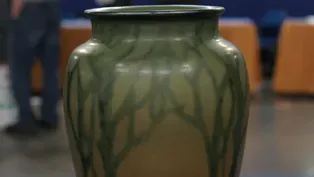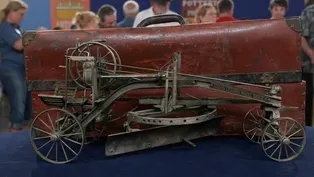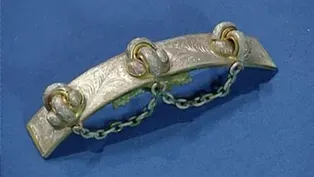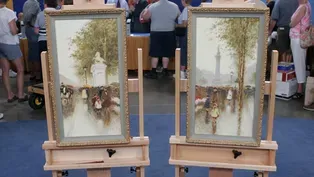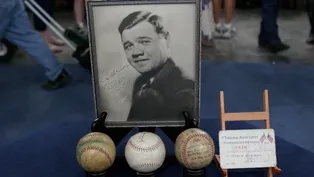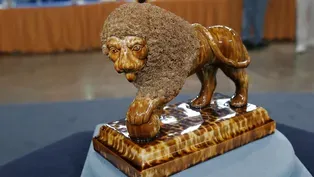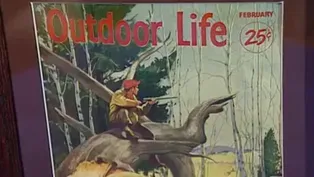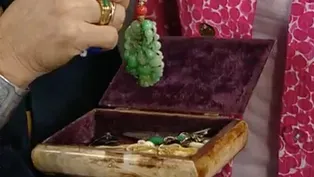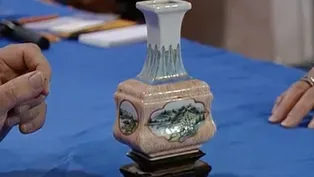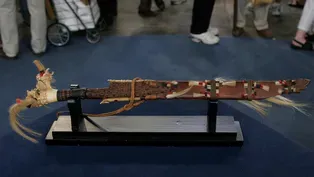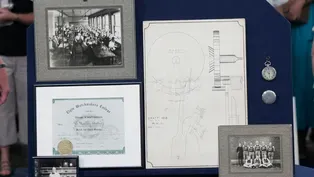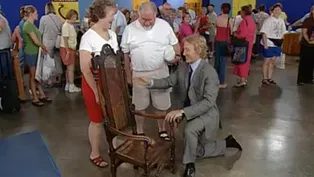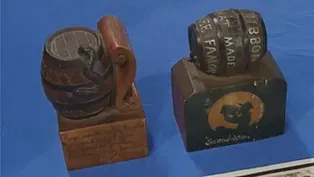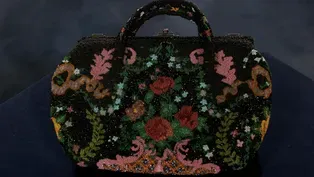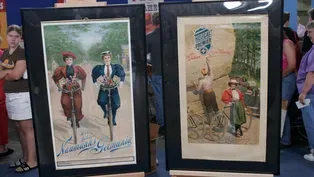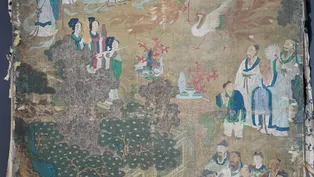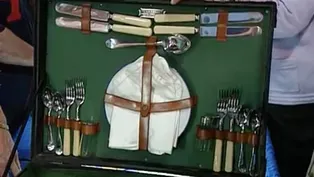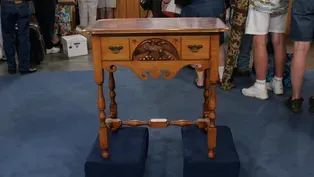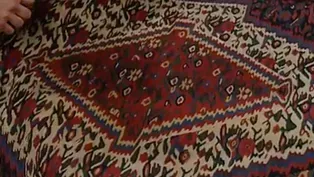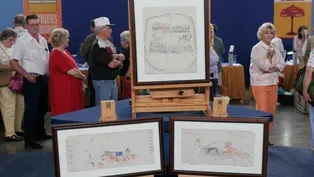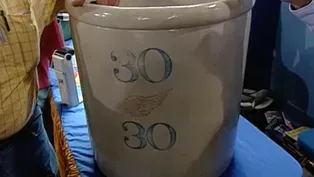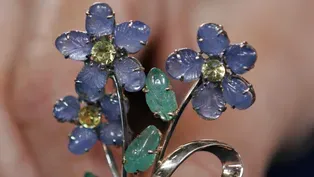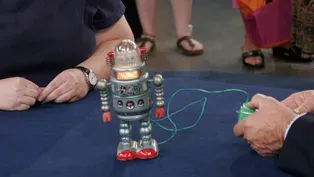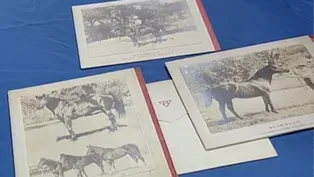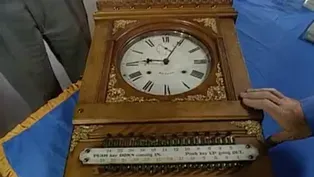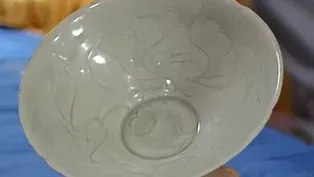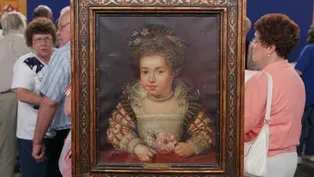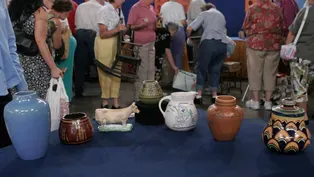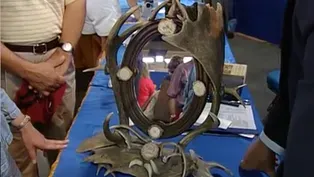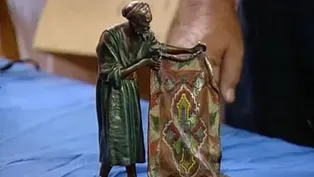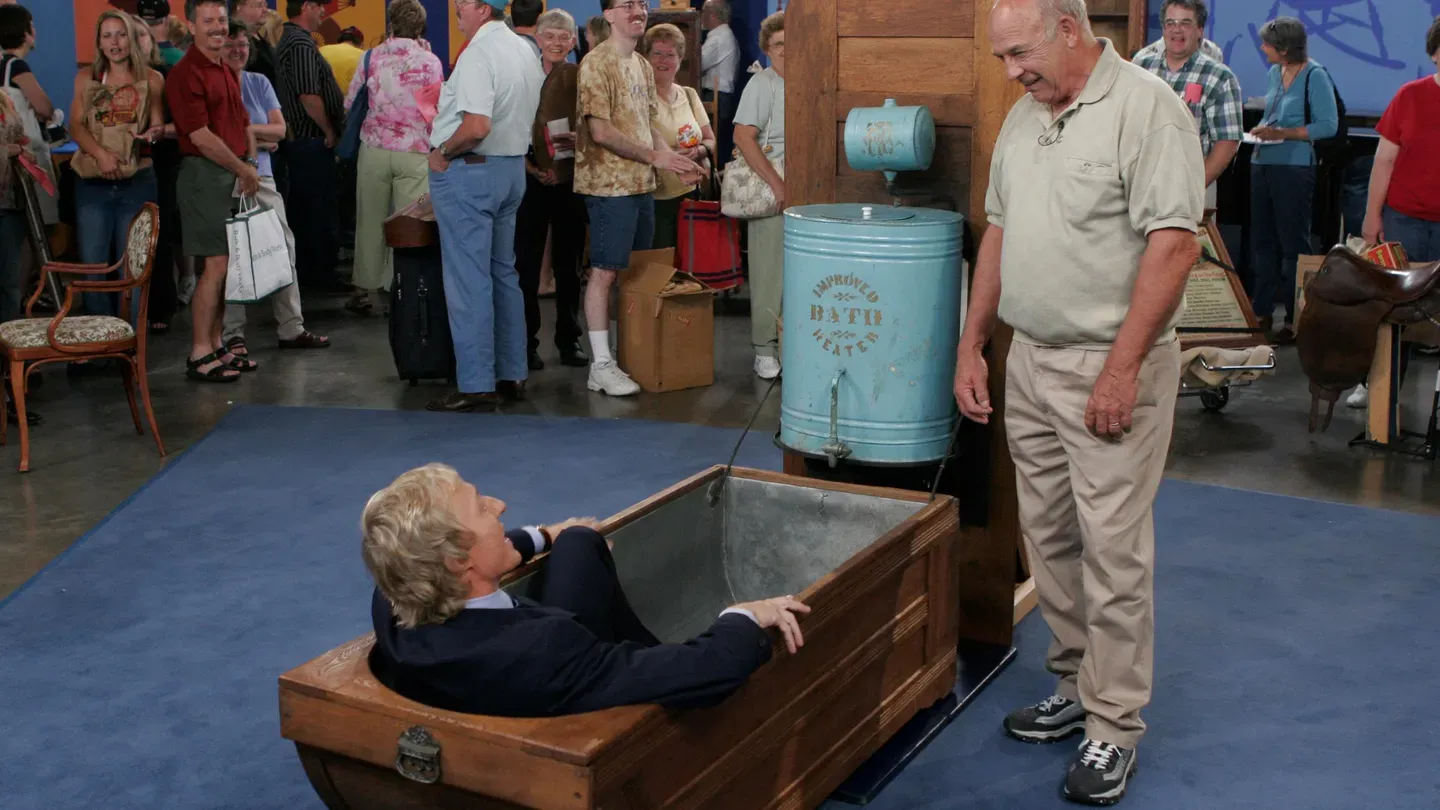

Vintage Bismarck
Season 23 Episode 20 | 52m 32sVideo has Closed Captions
Travel to Bismarck for Season 10 updates, including a value jump to $400,000-$600,000!
Travel back to Bismarck for updates on Season 10 appraisals like a UND School of Mines collection, a Korean court screen, and Native American pictograph drawings. Which has a jaw-dropping value jump from $30,000-$50,000 to $400,000-$600,000?
Problems with Closed Captions? Closed Captioning Feedback
Problems with Closed Captions? Closed Captioning Feedback
Funding for ANTIQUES ROADSHOW is provided by Ancestry and American Cruise Lines. Additional funding is provided by public television viewers.

Vintage Bismarck
Season 23 Episode 20 | 52m 32sVideo has Closed Captions
Travel back to Bismarck for updates on Season 10 appraisals like a UND School of Mines collection, a Korean court screen, and Native American pictograph drawings. Which has a jaw-dropping value jump from $30,000-$50,000 to $400,000-$600,000?
Problems with Closed Captions? Closed Captioning Feedback
How to Watch Antiques Roadshow
Antiques Roadshow is available to stream on pbs.org and the free PBS App, available on iPhone, Apple TV, Android TV, Android smartphones, Amazon Fire TV, Amazon Fire Tablet, Roku, Samsung Smart TV, and Vizio.
Buy Now

ANTIQUES ROADSHOW 2025 Tour!
Enter now for a chance to win free tickets to ANTIQUES ROADSHOW's 2025 Tour! Plus, see which cities we're headed to!Providing Support for PBS.org
Learn Moreabout PBS online sponsorshipEven though they were printed in large numbers, I've actually never seen either one of these two before.
(inhales sharply) Ouch.
(appraiser chuckles) Whoa.
And I brought it in an old bedsheet.
(laughing) Thank you!
(laughing) ♪ ♪ MARK WALBERG: Appraisals from "Antiques Roadshow's" first visit to Bismarck, North Dakota, were originally recorded back in 2005.
Coming up, you'll discover that 14 years has made a huge difference in the life of this screen that at one point was destined for the trash heap.
But first, what has Leslie Keno gotten himself into now?
You and I know what this is, but our audience doesn't know.
That's correct.
This is a case holding something inside.
Looking stylistically at this, I'm seeing these incised flower heads here, and the reeded pilasters.
And this is in the Eastlake style.
Now, that tells us it's made about 1880, right in there, this case.
Okay.
Probably made of chestnut during the Victorian period.
The suspense is building up.
Should we let them know?
Yes.
Should we do it?
I'm going to grab the handle.
You bet.
We'll pull this down.
If you can hold that side.
Yeah, I got it.
There we go!
Look at that.
In the 19th century, we had Murphy's beds, invented by a man named Murphy.
They were convertible beds to save space.
So in the late 19th century, someone invented that version in a bathtub with heated water.
Now, in all my years on the "Antiques Roadshow," I've never, ever seen one of these.
I had the local heritage center here check on it, and they couldn't find anything, either.
Where did you find this bathtub?
I bought this in Valley City, North Dakota, about two years ago.
What made you go for it?
I think it was the people that were stopping and looking at it, and I watched them for about an hour, and I was contemplating about buying it.
And I thought, "Everybody likes this thing."
"Where did you get this?"
they kept asking.
And I made her an offer, and I got it.
Good for you.
The history of hygiene in the world, and bathing and using soap, is kind of a slippery one.
(laughs) Now, you can have thousands of people in one town, and there'd be one bathtub.
So this is pretty amazing that this one survived.
It would have been made for probably a wealthy family.
It possibly came out of the Barnes estate in Valley City, because Barnes County is named after them, and she was close to 100 years old, or maybe over.
What you've got here is this canister with its original paint.
It says, "Improved bath heater."
Here's your kerosene canister, that gravity fed down the tube, right?
Yes.
And then underneath, here's this burner, which is adjustable, heat up the water-- take a long time to do that.
And then, of course, the hose here that would go into the tub.
That's correct.
Now, you also brought the stopper.
Yes.
That's the original stopper.
That's great you have that.
Now, if I was insuring this, because of the rarity, I'd insure this for around $3,500.
What'd you pay for it?
$2,500.
$2,500?
Good for you.
Good job.
Thank you!
Now, I'd like to try it out.
Do you mind if I take a... No, you can certainly.
Can I check it out?
Let me just see.
If you want to check it out, you certainly can.
Let me just see how... Actually, it's pretty comfortable.
That's not bad.
Very nice, thank you.
WOMAN: This is all pottery from the North Dakota School of Mines, and the clay was from there.
Most of it is from my mother and my grandmother.
But I have a few pieces from the instructors, too.
This piece... (chuckling): This wild-looking piece is one of my grandmother's pieces that she did.
This is a piece that was done by one of the instructors, as was this, the Viking ship piece.
This little piece, called the Telemarken, my grandmother helped design the design on this one, although it was made by one of the instructors.
What is the design?
It's dancing women.
It's a folk design.
And it says on the bottom, "Telemarken," and that's the valley that my grandmother's family came from in Norway.
And that's one of my favorite pieces.
Then she also made this little cow.
They had a herd of Jersey cows, and on the bottom is the cow's name and the year that it was made.
Her name is Kari.
The next piece is one that my mother made, and it was designed after a Native American design.
And the end piece is one that my grandmother did again, out at the university.
The ceramics department was set up in 1910 and went on until the '60s, and they taught so many thousands of students.
It was about promoting clays from North Dakota, of which they had a great many.
This is one of the special clays.
This is Bentonite.
Okay.
And the pieces made of Bentonite clay could be painted on and fired in a single process.
Okay.
And most of these pieces are marked in the same way.
Mm-hmm.
Which is with the U.N.D.
Indigo stamp.
Mm-hmm.
And this one is also signed by your mother.
And it is a student piece.
Yes.
It was like a community education class, people coming in from the community to take classes.
So some of these pieces that we see are made with sort of different levels of professionalism.
And some are done, as you were saying, by instructors, such as Margaret Cable, who did this one.
Right.
And she was the head of the ceramics department.
Yes.
And this is Julia Mattson, who was one of the instructors.
Mm-hmm.
And it's really good and tight.
Yeah.
A plainer piece like this... Mm-hmm.
...of which many were made... Mm-hmm.
Is worth about $200 to $300.
Okay.
At auction.
A Bentonite piece like this, even though it's a little rough and fairly obviously done by a student, but because it's Bentonite... Mm-hmm.
It's probably about $700 to $1,000 at auction.
(chuckling): My goodness.
These are rare; animals are rare.
People love cows.
Yes.
There is a little break, so that will cost it a little bit, but that would be $750 to $1,000.
(chuckling) Dear old Kari.
Pretty much the same with this, $750 to $1,000.
Oh, my goodness.
(chuckling): Okay.
This one, about $800 to $1,100, on the Cable pitcher.
Oh, okay, sure, that's...
This piece, which is decorated with a prairie rose design... Mm-hmm.
It's also your state flower, isn't it?
Right, it certainly is.
And that comes up very often.
That's a pretty popular pattern.
Yes.
And that has a good size and a lovely glaze.
That's a molded piece.
$1,000 to $1,500.
Oh, my goodness.
(laughing) And the humidor at the end, which is so bright and lovely and kind of unusual.
Very unusual, yes.
Unlike anything else I've really seen done there.
That's $1,500 to $2,000.
(laughing) My grandmother would be just amazed.
Here we have three wonderful Christmas cards from the early 1940s featuring Seabiscuit.
Anything Seabiscuit is hot right now, and it has been for a while.
Okay.
APPRAISER: I love this one here.
It says, "Kentucky whiskey."
And on the back, it says, "His spirit rests in private stock."
(man laughing) He must have had a great sense of humor.
MAN: I'm thinking maybe he did it during the Prohibition.
Probably.
APPRAISER: The nice thing that I really like is that it's so complete.
You've even got a nice thing here, which I've never seen, is the original cork in the flask.
So I see you've got two images of the same painting.
How did this come about?
My daughter found the original painting in a secondhand store.
The second is the magazine that it was illustrated for.
Do you know who the artist is?
I do.
Charles LaSalle.
That's right, it's signed down here.
And we had no idea until after she brought the painting home and found out that he was an illustrator for many magazines, did some "How to Draw" books with Foster Publishing.
Mm-hmm.
And later on in his life, was a Western artist.
That's right.
I think he moved to-- he originally trained in Boston, and then latterly, he moved to Arizona-- Scottsdale, I believe-- and was better known for his Western subjects.
Mm-hmm.
And this is a terrific...
I was so excited.
...hunting, shooting, fishing image.
Yes.
And here's the hunter up here.
Yes.
And I suspect this is the poor little fox down here.
He's not long for this world.
Mm-hmm.
So the subject helps it, when it comes to the market.
You have people who specifically collect that kind of material.
And, also, you've got people who collect illustration art.
He did work with "Saturday Evening Post," and also "Collier's."
During his advertising period, he was working with major companies, too-- with Ford and General Motors, General Electric.
But I think he really came into his own later on with the Western subjects.
So tell me, how much did you pay for these?
My daughter paid a dollar for the original.
Okay.
And I paid three dollars for the magazine.
This one I think at auction is worth $2,000 to $3,000.
Oh, that's wonderful.
And this one's worth three dollars.
That's what I thought.
(laughing) So I think you got that right.
Well, what a great find for a dollar.
That's wonderful.
WOMAN: This belongs to my husband now.
It belonged to his grandfather, who bought it new.
And when he passed away, his wife gave it to my husband, because he was the only member of the family that knew how to play.
We pulled out a couple of sheets of church music and a few pamphlets from a youth revival that he had played for.
And when his friends would come, they'd have a few drinks and sit around and play guitars.
Great.
You've brought in a Fender Stratocaster guitar, and, and without a doubt, one of the most coveted solid-body guitars made today.
Yeah.
It's what Eric Clapton called "a pure rock 'n' roll machine."
You've got an original case with it.
That first sort of line of inquiry is, of course, the serial number on the back plate of the guitar.
Though these are sometimes off by a year or so, and the true way to really date the guitar would be to pull the neck out and to read what might be either penciled or stamped here at the end of the fingerboard.
We're going to go somewhere where no one else has ever been, and ask your permission-- if you're comfortable with that.
Yep.
That's fine.
Yeah, all right, well...
I'm looking forward to it.
With mass-produced items like Fender guitars, they're made of component parts, and one of the geniuses of Leo Fender's inventions was to bolt the neck on... Yeah.
With four very simple bolts and a neck plate.
It makes removing these extremely simple, and at the same time, it made for a very easy repair.
From the feel of it, I don't think that it's ever been pulled apart before.
Has anyone, to your knowledge?
No, as far as I know, nothing's been done beyond, you know, string-changing.
We're pulling... Yeah, that's a great feel.
That's the kind of tension you want to feel on a screw that hasn't been cracked before.
And we pull the neck plate off, and a little bit of sort of gassing of the, of the lacquer underneath.
You can see this cloud it made.
And there's the nitrocized lacquer sticking on the back plate, which is quite wonderful.
And then a quick little... (clicks) Nice sound.
(laughs) And we have here a very interesting thing.
No date at all.
Now, there is rumor at times that they weren't always consistent in putting in neck dates.
And it doesn't worry me that there's not a penciled-in date at the end of this neck.
It's a well-known fact that between 1959 and 1960, Fender dispensed with writing in these dates.
Why?
Well, there happened to be an employee writing profanity at the end of this... these necks.
Leo Fender got word of it.
He said we're going to go to a rubber stamp, which they did in about 1961.
And looking at this guitar closely, at the pickups, at the knob controls, the quality of the varnish...
Without a neck date, I still think we're looking at 1959, and I think we're going to hang our hat on this.
On the serial number?
And the quality of how this is cracked, pulled out, and the fact that it's all very fresh in here.
An outfit like this is quite amazing to survive in this kind of condition for such a long period of time.
The amp is also from 1959.
Inside, on the label, there is a production order number.
It is I.E.
: "I" standing for the date, 1959, and "E" for the month of May.
Were you offered a price for this guitar at one point?
We were.
And how much were you offered?
$15,000.
A fair market value for this complete outfit would be easily $25,000.
Wow.
Well, thank you for bringing it in.
Thank you for looking it over and telling us.
It's pretty cool information.
Terrific.
WOMAN: This was brought back from the Orient by my great-uncle, who was a missionary over there.
And he gave it to my father.
It's a ceremonial sword.
It belonged to a chieftain in, I believe, New Guinea.
And I don't really know how Uncle Vernon obtained it, but he got it.
When he was in Borneo, they threatened to kill him, and they were going to eat him, but they saw that he had eczema on his legs, and they thought he was unclean.
(laughs) So he got by that way.
Well, actually, the story is, that is actually where this came from.
It came from Borneo.
Oh, from Borneo, hm.
And it was probably a high-ranking chief's sword, but not necessarily ceremonial.
These were actually used.
Oh.
And, in fact, the word for this sword is mandau, and it means "head taker."
Oh.
This custom of head-taking continued right through the 1930s, '40s.
This sword also is composed of various beautifully carved pieces of wood and deer antler.
I think this one section of wood at the top of the scabbard is actually camphor wood, because it has quite a fragrance to it.
Oh.
This hilt is deer antler here, and it's carved with all sorts of fantastic monsters that are swirling all around it.
And then there are these tufts of human hair that have been dyed, and they've been dyed a yellowish-white, black, and red.
And the reason why they've been dyed those colors is, they're to resemble hornbill feathers, the hornbill bird.
Oh!
Because a hornbill bird is actually a symbol of war for them.
Oh, I see.
Chiefs actually wear headdresses of hornbill feathers.
And then you also wanted to know what was up with this.
Well, I was told that the carving was done with that knife.
It's called a pisau raut, and what it is, it's for cutting bamboo into thin little strings in order to use it for basketry work.
Mm-hmm.
They used bamboo for a lot of things over there.
Exactly.
When he bought it, it might have been 50 years old at the time.
It's probably a late-19th-century one.
But it's a finely forged blade, a beautiful thing.
The sword and the rattan knife would probably sell at a good day for auction for about $1,500.
Mmm.
And it's actually a substantial amount of money, because a lot of these don't command those kind of prices, but this one is a particularly spectacular example.
MAN: This is a picture of my father.
He went to the Elgin watch college in 1922, '23, '24, and got his degree in 1925.
And this is a watch over there that he made.
And this is his drawings for making the watch.
This shows my dad in the basketball team, and this is my dad right here at Elgin watch college.
He made it in 1924.
It's number 13.
It's great that you still have his certificate from watchmaker's school.
You know, a lot of these things can get lost over the years.
And his drawings.
Yeah.
It's not often we see these drawings.
You have some 25, 30 of them.
That's right.
And they're technical drawings that he would have had to complete, along with his watchmaking course, for different movements, lever escapements, different wheels, because he not only had to know it on paper, he was going to translate it to his work at the bench.
Elgin was the largest manufacturer of watches in the United States.
From 1864 to 1964, they made some 55 million watches.
They basically made almost half of the total production in the United States.
In Elgin, Illinois.
In Elgin, Illinois.
Correct.
Here's the watch that he made.
Now, I'm going to flip it over.
Mm-hmm.
I'm going to show everybody the movement.
You said that he made the watch.
From scratch.
From scratch.
Now, a lot of these parts are die-struck and machine-retooled.
So he may not have actually sat down and made every single little part, but he certainly had to tune them, fit them.
You have over a hundred pieces in here.
Mm-hmm.
That takes upwards, towards 2,000 operations to put it together.
Oh, really?
But what he did do is, he customized the watch, also.
Mm-hmm.
These plates, these large areas, are usually solid throughout here.
Mm-hmm.
What he did was, he sat down and he pierced them with a saw.
And he customized it.
Number 13 is the number he put on it.
He also put the date, and then he wrote his initials.
It doesn't have a regular Elgin serial number.
Why?
Because he was making this in the class.
For himself.
Exactly.
You can see, also, on the back cover, he put his initials, nicely engraved.
I think when you put it all together, especially to somebody who collects Elgin... Mm-hmm.
And tie it in with the drawings... Mm-hmm.
I think you have something that would, at auction, probably bring $1,500 to $2,000 today.
Oh, really?
(chuckles) I'm surprised.
I had no idea.
Of course, it's not for sale.
We display it.
Well, it's great things to have in the family and pass down through the generations.
Absolutely.
WOMAN: This painting was purchased from a Russian antique dealer in Chicago many, many years ago.
It's been hanging in a back bedroom.
And when the Antiques Roadshow was coming to town, we thought maybe it was time to dust it off and have somebody take a look at it.
It's a portrait in the style of the 17th-century Flemish painters.
We have this wonderful label here that says it's by Pourbus, Frans Pourbus, who was a member of the Flemish Pourbus family in the 16th and 17th century.
Wow.
We also have the name of the sitter.
The portrait of Henrietta of France.
Mm-hmm.
Henrietta later became the wife of Charles I of England.
So that's what we can tell from the front.
But the back is where our portrait really gets interesting.
From the back of the painting, we can tell, first, that it is not a 17th-century frame.
It's rather a 19th-century frame in the style of the 17th century.
The same is true with the stretcher that the painting itself is on.
And then we get even more information.
Here we have Francesco Pourbus.
And it's in Italian, because the painting, as identified on the front, is actually in the Uffizi Gallery in Florence.
And here we have a seal from one of the supervisors of the studio at the Uffizi, the copyists' studio at the Uffizi, saying that this is, in fact, an authorized copy of a Pourbus painting.
It went on to Rome to be sold, and eventually came to the United States.
During the years between 1840 and roughly 1940, people were visiting Europe.
And when they would come back, they would bring back wonderful souvenirs of their trips.
We bring back snow globes now.
They brought back wonderful replicas of important paintings, and that's what you have here.
The unfortunate news is that an original Pourbus painting could be in excess of $100,000.
Some of them are very, very valuable.
But this is a lovely 19th-century copy.
Given the condition of this piece, the losses that you have, this piece at auction I would value at between $1,500 and $2,500.
Wow, thank you.
Yes.
Much better than a snow globe.
Much better than a snow globe.
(laughing) Thanks for coming.
Thank you.
APPRAISER: We look at the base, and we see the kind of creamy color.
That's, that's something that's what we call porcelaneous.
It's not quite porcelain.
It's pre-porcelain.
This actually dates to the Song Dynasty in China, which is the 12th century.
WOMAN (chuckling): Oh, wow.
I had no idea.
Isn't that cool?
The importance to me, really, isn't the doll itself.
It's where it comes from, '36 Olympics.
WOMAN: Right.
What's really wonderful about it is the original tag.
You have the original Olympics medallion and the original Olympic shirt.
It's a nice little thing to find in the attic.
Absolutely.
And good thing it's still in such great shape.
When it was made in the late 1800s, it was considered very precious metal.
But it is made out of aluminum.
Aluminum then was a rare metal.
Just came out.
Okay.
And the jewelers wanted to make jewelry out of it.
And then they found out later on, worthless.
It went downhill and nobody wanted it anymore.
Now it's back.
Oh, okay.
It became collectible.
MAN: I purchased it from the previous abstract title company, and it's been in that company since 1936, that I know of.
How long you have owned it?
16 years.
16 years.
Mm-hmm.
Well, this particular clock was made by the Seth Thomas Clock Company, and it's an unusual clock, because it was built for a purpose of tracking when people were coming and going.
It was probably used in a boarding house or, perhaps, a hotel of some kind.
And every room would be assigned a number.
When a guest went in and out, they would flip one of these switches, and then when he returned, they probably flipped it back up again.
That, in turn, made a mark on a piece of paper that would have been on this roll here, and they would have been able to record the motion of that person over a period of time.
It's interesting that this is spring-driven-- big spring here on the fusee-- and it runs through cables over here.
The clock itself is pretty basic.
Seth Thomas used this movement in a lot of clocks.
It probably runs for 15 days.
And it's really good quality.
It's nice that it has this Minneapolis, Minnesota, Time Recorder Company on it.
Do you have any idea what value a clock like this would have?
I don't know.
I paid $100 for it.
That's pretty good.
In today's marketplace, there's a lot of interest in time-recording clocks, and this particular clock, I would probably estimate the value to be about $2,500.
Wow.
Mm-hmm.
MAN: Well, it's shown in an old tintype.
Somebody in the family's got that.
It's been in the family for a long, long time.
I grew up with the guy sitting on the top of the piano.
But after we were married, when it finally came to me, along with this piano, my wife was afraid to let it stay out.
So my kids haven't had a chance to grow up with this the way I did.
It's been in the closet for the last 16 years.
How far back in your family can you put it?
At least as far back as my great-grandfather.
It's actually pretty special.
Now, I'm going to look at the mark first, because the mark is going to explain a lot.
Uh-huh.
And I'm curious as to, have you ever tried to read the mark before?
Or did you even know there was a mark on the bottom?
Well, I knew there was a mark.
And somebody gave my mother a book about Bennington pottery.
Right.
So we've got some idea that it's more valuable.
Well, this mark actually says "Fenton, Lyman, & Company."
Now, you're correct in that it does come from Bennington.
And the Fenton & Lyman Company was at that point in time, in 1849, a manufacturer of pottery in Bennington.
Mm-hmm.
And they made these lead-glazed, which they actually called flint-glazed animals.
They made utilitarian wares, like kitchenwares.
They made things like picture frames and flasks and they made these wonderful animals.
Now, this on the top here is actually where they've taken little bits of clay and they've chopped it up.
In fact, they call this technique coleslaw.
Uh-huh, coleslaw?
These have always been desirable.
If you go back to the 1920s and 1930s and '40s, there were collectors that desired these back at that point in time.
Mm-hmm.
And even more so today.
Now, these were made in pairs originally, so there was a left and a right, if you can believe it.
Uh-huh, yeah.
And you just have one of a pair.
If this came up at a well-publicized auction, I would expect it to sell in the range of $4,000 to $6,000, conservatively.
Uh-huh.
And, certainly, to insure it as much as $7,500 or $8,000 wouldn't be unreasonable.
(inhaling sharply): Ouch!
(chuckles) So is it going on the piano, or is it going back in the closet?
I'm afraid it's going to go back into the closet.
WOMAN: This is a bead bag purse that I bought on a trip to Sioux Falls, South Dakota, on a little antique outing.
I didn't know much about it, but I just fell in love with it.
I paid $175 for it, probably about ten years ago.
Most beaded bags from this era, which is about 1915 through 1925, are about half the size of this purse.
And what is amazing about it, beyond the size, is the condition.
It's a floral pattern, and we've got several colors of glass beads, and there's approximately 150 beads to square inch.
It's the same pattern on both sides.
I figure this weighs almost six pounds, maybe more.
Mm-hmm.
It also has handles embroidered with beads on both sides.
Yes, I noticed, sure.
And they're very, very, very good condition.
Where do you think this purse was made?
This is just a guess, but I thought possibly France.
Okay.
Because it's so beautifully done.
I think you're right.
Really?
Okay.
I think it's made from... Not only because the design is so exquisite... Mm-hmm.
But when women in America made purses-- and this was a cottage industry, they would make them in their home-- they would put in a single quadrant of the purse a white bead, and there is no white bead on this purse.
Oh.
So it's not a signature American piece.
I want to show the lining here.
It's in excellent condition.
It's a cotton sateen lining.
Okay.
It's got a very nice Art Deco, '20s-'30s pattern.
The hardware is not sterling, it's stamped steel.
It doesn't have a chain, but it does have a sliding locking mechanism right here.
It also has the original mirror.
And I think this is the original lining.
I looked at it.
It seemed to be hand-sewn.
I would say on today's market, a purse of this exceptional quality would bring around $2,000.
Oh, that's wonderful.
(giggles) That's wonderful, thank you.
These were done for my great-aunt, who was a missionary down on the Standing Rock Reservation, which is just south of here.
She was a missionary there from 1885 to about 1920.
She was in charge of passing out commodities periodically, and before she would pass them out, she would tear out a ledger sheet, and then have the Indians draw her a picture.
So I've had them since 1965, not knowing that I even had them until we were going through some of the old boxes, and they were just laying loose in the boxes, so finally we dug them out and I had them framed then.
Well, they're nicely framed, and they're quite beautiful drawings.
They're Plains pictograph drawings.
This represents a sun dance.
It's nice because it's dated, 1895, and it has the name, "Drawn at Little Eagle, South Dakota."
It represents the brush arbor for the sun dance.
The central sun dance pole.
And it's beautiful because the warriors have all their society gear on.
They have society lances, bandoliers.
There's one warrior who seems to be pierced at the breast and actually performing the sun dance.
There's a couple back here that look like they're about ready to go on.
The detail is just magnificent.
The headdresses are beautiful.
I think your ledger book drawings are a little bit earlier.
They have a feel, pictorially, for, I'd say, 1870s to 1880s.
This one is a magnificent drawing.
Warriors used to prove their prowess by charging out in front of the cavalry.
They'd run the line, they'd say.
And a lot of times they'd get back.
Sometimes they wouldn't get back.
This guy, obviously, lived to tell the tale, because he probably drew this drawing.
But he got shot twice, and his horse got shot about eight times.
And his name was probably associated with the elk.
I notice his name glyph up here is an elk.
And all he's carrying into battle, he's got his pistol holstered, and he's carrying a coup stick.
So he charged a whole line of guns with his coup stick.
So a very brave warrior.
This is a wonderful drawing, too.
I suspect he's a cavalry man, but he could also be a Plains Indian scout.
He's carrying a flag, but he has shot his horse, and he's counted coup with a quirt, which was very common.
And he's got a very unusual name glyph.
It's two horse tracks with bullets flying.
They're absolutely beautiful pictographs.
Have you ever had them appraised?
I never have.
I saw in a magazine one time where they had a similar thing, and this was about ten years ago, and I think they said that that time, they were $3,000.
Mm-hmm.
Well, I understand you have more at home, too.
Right.
I think your sun dance piece would easily sell at auction for about $8,000 to $12,000.
Wow.
And I think both your ledger pieces would probably bring about $4,000 to $6,000 each.
So if you've got 16 more... Yeah.
...you've got quite a treasure trove.
But at auction, you're talking probably about $16,000 to $24,000 in these three drawings.
That's amazing.
Oh... boy-- mm.
WOMAN: There's one thing that's wrong with the piece.
It's got a piece missing.
You see that?
The carving is not all there.
But this is around late 19th century.
It's a Chinese jade carving with a coral bead.
It had more to it.
If this were perfect, it would be worth around $3,000.
It's still worth between $800 and $1,200.
WOMAN: Oh, wow.
Red Wing Pottery started in Red Wing, Minnesota, in the 1870s.
They made primarily utilitarian ware, and then in the 1920s, they had an art pottery line.
It's a 30-gallon crock, which is a pretty big crock.
This is made in Iran.
What we call Iran today would have been called Persia back then.
Probably made in the 1930s or 1940s.
And these design elements are mostly what we call stylized fish.
Oh, okay.
And this is meant to be like a reflecting pond with the fish in and around it.
WOMAN: We found it at an antique store in Winnipeg, Canada.
APPRAISER: What did you pay for it?
I think we paid about $200.
Okay, this type of chair, these cane-backed chairs, were brought into the colonies from England from, like, 1680 to 1710.
They were really used a lot in Boston and Newport.
And then they started making American versions of them here.
Oh, okay.
Okay?
So my first thing was, is this American or is it English?
If you look down at this wood right here, these little flecks show that this is beechwood.
I don't see any maple on this, so it is an English chair.
This type of chair, with the carved crest rail, and if you come down here, this ram's horn arms-- handholds.
Then this lower stretcher, which is carved, it's a high-style version.
What it's missing, the reason it's low, are the feet.
This had probably ball feet that were down here.
They've been cut off, and that's why it's so low.
Oh, right.
Okay.
But it's a William and Mary chair.
You'd also call it, a little bit of Jacobean influence.
You paid you said $200.
$200.
This is probably worth about $1,200 to $1,400, so you did okay.
Okay.
Do you want to know how much it would be worth if it were American?
Yes.
You would?
Okay.
About $250,000 if it were a Boston 1710 version.
They're rare as hen's teeth.
APPRAISER: Sometimes the most ordinary boxes possess some pretty extraordinary things.
MAN: My father owned a construction company for many years.
I've had it since the 1940s.
It's a scale model of an early Adams leaning-wheel road grader.
And the operator would stand back here, and it would be pulled by either horses or mules or tractors, when they came.
And my understanding is that this was a salesman's sample.
The salesman could carry this around in this case and show this machine for them to use to build roads when this part of the country was first being developed.
You think of just how hard a salesman had to work in this time, how many miles he had to log.
You see how worn the case is.
But, also, you focus in after that on how wonderful this machine is.
The salesman had to stand up there not with a picture, but with an actual model saying, "This is what it can do.
This is how we're going to make your life a lot better."
And hopefully, he was successful at it.
We see the angled wheels.
That slants the rear wheels.
Uh-huh.
And this one slants the front wheels.
Right.
That's for operating on the side of a hill.
And on the side here, it says, "Adams leaning wheel grader," so it's telling you exactly what it is.
At this point, this was an industry, but it was an art form, in the sense that this really, truly takes on a sculptural quality that's better than a lot of things that are done.
There's a lot of pride that goes into this.
And it was this that made him able to sell these to so many of the towns and create the roads that we see around the Great Plains.
Right.
I would say that probably in a well-publicized auction where there are some other salesman's samples, you'd probably be expecting somewhere between $6,000 and $8,000, so... Wow.
I had no idea.
MAN: Both of the items were my grandfather's.
He came here in 1888 from a little town in Bohemia called Nickelsdorf.
They were in his trunk.
He was 11 years old when he came to the United States.
APPRAISER: They're what we call window cards.
Each one of them has a metal strip across the top and across the bottom.
And, also, in that metal strip, there's a little loop.
And this was actually used to hang it in shop windows.
Now, both of these are bicycle advertisements, so we have to imagine they were hung in the windows of bicycle shops to promote the wares that were being sold inside.
And they're both printed by a process called chromolithography, which was very prevalent in Germany in the 1890s, which is consistent with the date of your grandfather's trip to America.
And I've done a little bit of research, and I've spoken with many of my colleagues here at the Roadshow, and I've mentioned them, the names Naumann, and I've mentioned the names Helical, and no one's ever heard of them.
And so what this says to me is that these are bicycles that were mass-produced in Germany, but the companies then went out of business.
But from a collectible point of view, that's not where the interest lies in these pieces, nor is that where the value lies.
Now, in the 1890s, bicycles were the hottest seller, basically in any market.
And specifically, bicycles were marketed to women.
And you'll see in both of these posters, the main subjects are women.
In this poster nearest to me, you actually see two very affluent, well-dressed, stylish women out for perhaps a Sunday afternoon ride in the park.
In the poster closer to you, not only do we see an emancipated woman who has gone for a ride with a man in the countryside-- which would have been a fairly risqué idea in the 1890s-- but if you look at her pose, she is a very self-confident, a very modern woman.
But there is actually a poster within the poster, because we see here in the background something that's called a poster kiosk, which in Europe during the 1880s and 1890s, were basically used as billboards for people to hang up their posters and to advertise.
So here you actually see another advertisement for the bicycle company on the kiosk in the back.
Each of these posters has a blank space on the bottom.
And that would have been left for the individual stores to fill in their information.
Naumanns bicycle and Helical bicycle, they would have printed these posters in fairly large numbers.
Neither of these two posters is signed, and a poster of such high quality, you think, would be attributed to a really great artist.
But the Germans who were making these chromolithographs were such great craftsmen, that at the printing plant, the printers were all artisans themselves and they designed these posters.
And even though these posters have the metal strips on them, this is not considered a problem.
This is considered part of their authenticity.
If I had these two pieces at auction, as a pair, I would estimate them at $3,000 to $4,000.
Wow.
Even though they were printed in large numbers, I've actually never seen either one of these two before.
And the chances are that price could go higher at auction.
Really?
MAN: The baseball is signed by Babe Ruth, to Bud-- that's me.
I was just under two years old when he came to Fargo.
He signed the picture, "To Buddy," and this is a baseball autographed by Grover Cleveland Alexander, a great pitcher in the American, National League.
I got that one when I was about ten or 11 years old under the stadium in Wahpeton, North Dakota.
He was taking a shower out of a bucket.
He was barnstorming across the country.
He lived in Los Angeles.
This is a 1936 home run ball hit by Red Kress of the Washington Senators.
And it's signed by all of the Senators, a friend of my dad's.
It was through my dad that all of these things happened.
My dad got a pass here from the National Association of Professional Baseball, signed in 1938.
And that gave him free access to any baseball park in the United States.
Terrific, and the baseball pass ties in the provenance and story that you're telling, your dad having the access to the ballparks and being there.
The Babe Ruth photo is wonderful, signed to you.
The ball, Red Kress was your dad's friend, so you have the team ball there, and the Grover Cleveland, as well as the pièce de résistance, which is the Ruth and Maris ball.
Unfortunately, the Ruth signature is a little bit smudged.
Right.
But when you flip it around here, and we get a nice image of the Roger signature, it's a strong signature.
Roger Maris was signed by my father into professional baseball when he pitched in Fargo for the Fargo-Moorhead Twins, a class-C, Northern League at that time.
I watched Roger play high school football in Fargo.
He was a great football player, a great athlete, and a wonderful guy.
And to have those two on the same ball...
It's fantastic.
As far as value goes, for auction, we'll start over here with the '36 ball, the Red Kress ball.
I didn't put that in there too much for the value as much as just to tie in the provenance.
It's a '36 Washington Senators team ball.
You could still estimate that anywhere from $700 to $1,000.
For Heaven's sake.
The Grover Cleveland Alexander is a really nice ball.
Not a strong signature, but it's a white ball, nicely done.
That's between $2,000 and $3,000.
The pass has more sentimental value than dollar value.
Right.
And that's something I'm sure that's going to stay in the family for a long time.
Now, your Ruth photo.
It's a very strong signature with a nice inscription.
A personalized Ruth photo like this you could estimate at $3,000 to $5,000.
And the baseball here, again, signed by Ruth on this side and Maris on that side, I would place a value of that, only because of the smudging and a little bit of the faintness on the Roger Maris, at about $4,000 to $6,000.
So overall, what you're looking at basically is a package that's somewhere between $10,000 and $15,000.
Oh, my gosh.
You've got this oval Victorian mirror here.
Mm-hmm.
You have all these horns.
You've got a boar's tusk, and what we call the butt of the deer horn.
Mm-hmm.
Where they used to carve and make these wonderful ladies' brooches that they would wear.
It's mid 19th century.
They call this motif at the top acanthus leaves here, and then this is what... You know, they'll use a French word for this, faux bois.
Basically, fake wood.
It's to look like wood grain.
I grew up in the same town as Mr. Chapman and a lot of other artists.
It was, like, an artists' colony outside of New York City.
He gave this to me.
And it was a picture that he had painted up there on the St. Lawrence River, where he had his family home.
MAN: We bought this particular piece at an estate auction about 30 years ago.
Mm-hmm.
Uh-huh.
What attracted me to the piece was its uniqueness and design.
And what did you pay for it then?
We paid $12 for this particular piece.
$12, uh-huh, uh-huh.
Well, it turns out, you know, it's what we call a Vienna bronze.
It was made in Austria around the turn of the century.
It's interesting that it's not marked, but most of these are done by what was called the Bergmann Foundry.
And many of them were actually sculpted by Bergmann, himself.
And he developed this process of casting bronze, and then we call this cold painting.
Most bronzes have a patina on it that's put on with acid, various chemicals, acids with heat.
Whereas, this is actually painted with oil paint, once, once the bronze is finished.
And they liked to do these Middle Eastern figures.
Sometimes we see exotic dancers.
This rug merchant who is standing here displaying his wares.
These are very popular collectibles.
And the value is quite different from what you paid for it.
At auction, a piece like this now would bring between $2,000 and $3,000.
Is that correct?
Yup, yup.
Yeah, so you made a great, great buy.
My goodness.
WOMAN: It was originally my dad's, and I like to say it's mine, but I have six brothers and two sisters, so I think we kind of fight over it.
APPRAISER: Uh-huh.
And you didn't find a box or anything like that?
No.
This is a robot that was made in Japan in the 1960s.
There were a lot of different makers, and I think this one was made by a company called R.O., but it's really a little unclear as to who made what, because they all swapped parts and they had different names on the boxes.
It's battery-operated.
And it is called the revolving flashing robot.
Why?
Because... (whirring) Well, he walks like this...
But then, when you push this button, he revolves and flashes.
So, therefore, we call him the revolving flashing robot.
And he can do both things at once, I think.
Let's see.
Oh, no, he can't.
He can't walk and chew gum at the same time.
(whirring stops) I know you were concerned if it wasn't working, we wouldn't have a story.
Well, if this were totally not working, for about $35 to $50, we could have it fixed, which might seem a lot to pay to fix a toy that originally sold for $1.98, but it's worth a little more than $1.98.
Now, if you'd only found the box, we would be looking at a robot that was worth about $3,000 to $4,000.
Oh, boy.
Because the revolving flashing robot is one of the rare ones.
He's in amazing condition.
A little scratch right here, but that's not a big deal.
So without the box, I would say at auction, it would bring somewhere between $1,200 to $1,800 on today's market.
Mmm.
So go back.
Maybe that box is somewhere.
(laughs) WOMAN: I bought them in a gallery in Minneapolis in 1959.
They were in the window, and as I walked by, I thought they were very pretty.
Mm-hmm.
And that they would look wonderful in a special place I had in my living room.
So you bought them as a pair.
I bought them as a pair on the spot.
Hadn't gone in planning to buy paintings or anything.
Okay, and you know who the artist is?
Well, I read, or they told me it was Gisson?
I'm not sure of how you pronounce it.
Right, his name is André Gisson.
Did they tell you anything about him?
The only thing they told me that he was getting old, and he was starting to go blind.
Really?
Okay.
Mm-hmm.
Well, you do, in fact, have two views of Paris.
And you can see down here it is signed, "A. Gisson," G-I-S-S-O-N. Oh, I didn't-- I didn't see the A.
They're both signed.
Now, nice Parisian views, but the artist wasn't French at all.
Oh!
It's one of the great stories.
He was a struggling artist.
He was born in Brooklyn.
(laughs) His name was Anders Gittelson, of all things.
Oh, for heaven's sakes.
And he was born in 1921.
And so what he did is, he backed up his dates.
He said he was born in 1910 and was named André Gisson.
And he lived in Westport, Connecticut, most of his life, and painted there.
Oh, uh-huh.
So that's why they thought he was getting older.
And his biography, one of his galleries wrote, the very first line, it says, "Born outside of Paris."
I guess Brooklyn counts as outside of Paris.
But they weren't lying.
Yeah, they weren't lying, no.
Yeah.
He died just recently, in 2003.
Did you pay a lot of money for these?
I paid $150 for each one.
$150.
For each one.
Well, his paintings have come up a little bit more in the market recently.
Good.
So if I were to put these into an auction, I would probably expect to get $3,000 to $4,000 for them, for the pair.
Mm-hmm, oh, good, good.
My son will be glad to hear that.
He's inheriting them.
Oh, he will, good.
(laughs) WOMAN: My husband had this when we were first going together.
APPRAISER: Mm-hmm.
WOMAN: And he had gotten it from his uncle.
It didn't fit in our home anymore, and so we stored it, and quite regretfully, it got damaged, and I want to know if it's worth any value or if it's something to just kind of discard and say, "Too bad, it's gone."
Chinese painting is done in a narrative fashion, so you have the same figure represented in different poses.
And this is the figure of a woman named Xiwangmu.
She was sort of the leader of the immortals, which is this heavenly band of deities in Chinese mythology.
Really?
And they lived on an island called Penglai-shan, which is the island of the immortals.
If you look at this figure here, see the details?
WOMAN: Mm-hmm.
APPRAISER: There's gold decoration on the robe, beautifully painted, which is characteristic of a type of design that you find often on Coromandel lacquer screens from the late 17th, early 18th century.
And I think that's when this dates from.
Wow.
So we're talking about some time in the 18th century.
The big question is, what is the effect... of sitting in the water in the basement?
Mm-hmm.
APPRAISER: And it's lifting from the paper and wooden background.
And even some of the pigments are starting to lift from the silk surface.
Nonetheless, the quality of it is superb.
You rarely get scenes like this, which is a banquet scene, probably given to a very high official for a birthday celebration.
Anyone that could have afforded this screen lived in a tremendously large compound with a very high-ceilinged home, had a lot of money.
So this was something that was meant for the very highest tiers of society.
I think-- and my colleagues agree-- that the value of this has to be in the $30,000 to $50,000 range, as it is now.
(laughing): Oh, my goodness.
And I-- I was wondering whether I should... What were you wondering you were going to do?
(laughing): I didn't know whether it should be saved or not.
Oh, my goodness.
APPRAISER: It's certainly not something to leave in the basement.
Heavens, no!
And I brought it in an old bedsheet.
(laughing) Thank you!
(laughing) WALBERG: You're watching "Antiques Roadshow: Vintage Bismarck."
WALBERG: And now, it's time for the Roadshow Feedback Booth.
Our hat's off to Bismarck for hosting this show.
We really enjoyed it here.
And this hat, as it turns out, is quite valuable.
From the turn of the century, made out of pine needles, if you will, for the firemen to wear.
It's a fatigue cap for them.
I came here with, like, these little things.
They belonged to my dad.
They were actually worth, like, 15 bucks, which surprised me, because they're kind of cheap, and I thought they'd be worth 15 cents.
What I brought was something for you old yippies!
Wasn't worth as much as we thought, but we had lots of fun.
We came down for the Antiques Roadshow, and had a ball!
The best bargain is our shirts.
We got them autographed by some cool appraisers around here.
And they found out we have a hot state of North Dakota.
I drove 17-and-a-half hours from southern Illinois to get here.
And this is about what's worth showing.
That's the best thing I brung.
I bought this duck decoy with about a week's worth of lunch money when I was going to college 32 years ago.
Kept it in the house ever since.
Felt fairly sure this would be the down payment on a new pickup, and it's not.
(laughing): But we had a great time today.
WALBERG: I'm Mark Walberg.
Thanks for watching.
See you next time on "Antiques Roadshow."
Appraisal: 1925 UND School of Mines Vase
Video has Closed Captions
Clip: S23 Ep20 | 1m 3s | Appraisal: 1925 UND School of Mines Vase (1m 3s)
Appraisal: 1936 Olympic Sports Doll
Video has Closed Captions
Clip: S23 Ep20 | 22s | Appraisal: 1936 Olympic Sports Doll (22s)
Appraisal: 1959 Fender Stratocaster & Amp
Video has Closed Captions
Clip: S23 Ep20 | 3m 48s | Appraisal: 1959 Fender Stratocaster & Amp (3m 48s)
Appraisal: Adams Leaning Wheel Road Grader Sample
Video has Closed Captions
Clip: S23 Ep20 | 2m 6s | Appraisal: Adams Leaning Wheel Road Grader Sample (2m 6s)
Appraisal: Aluminum Jewelry Set, ca. 1880
Video has Closed Captions
Clip: S23 Ep20 | 30s | Appraisal: Aluminum Jewelry Set, ca. 1880 (30s)
Appraisal: André Gisson Paintings, ca. 1955
Video has Closed Captions
Clip: S23 Ep20 | 2m 3s | Appraisal: André Gisson Paintings, ca. 1955 (2m 3s)
Appraisal: Baseball Memorabilia
Video has Closed Captions
Clip: S23 Ep20 | 3m 1s | Appraisal: Baseball Memorabilia (3m 1s)
Appraisal: Bennington Pottery Lion, ca. 1850
Video has Closed Captions
Clip: S23 Ep20 | 2m 32s | Appraisal: Bennington Pottery Lion, ca. 1850 (2m 32s)
Appraisal: Charles LaSalle Illustration, ca. 1953
Video has Closed Captions
Clip: S23 Ep20 | 1m 47s | Appraisal: Charles LaSalle Illustration, ca. 1953 (1m 47s)
Appraisal: Charles Shepard Chapman Painting, ca. 1930
Video has Closed Captions
Clip: S23 Ep20 | 24s | Appraisal: Charles Shepard Chapman Painting, ca. 1930 (24s)
Appraisal: Chinese Jade Carving, ca. 1875
Video has Closed Captions
Clip: S23 Ep20 | 27s | Appraisal: Chinese Jade Carving, ca. 1875 (27s)
Appraisal: Convertible Bath Tub, ca. 1880
Video has Closed Captions
Clip: S23 Ep20 | 2m 37s | Appraisal: Convertible Bath Tub, ca. 1880 (2m 37s)
Appraisal: Decorative Chinese Vase, ca. 1850
Video has Closed Captions
Clip: S23 Ep20 | 25s | Appraisal: Decorative Chinese Vase, ca. 1850 (25s)
Appraisal: Dyak Sword & Rattan Knife, ca. 1875
Video has Closed Captions
Clip: S23 Ep20 | 2m 48s | Appraisal: Dyak Sword & Rattan Knife, ca. 1875 (2m 48s)
Appraisal: Elgin Student Watch & Papers, ca. 1924
Video has Closed Captions
Clip: S23 Ep20 | 2m 54s | Appraisal: Elgin Student Watch & Papers, ca. 1924 (2m 54s)
Appraisal: English Cane Back Chair, ca. 1700
Video has Closed Captions
Clip: S23 Ep20 | 1m 15s | Appraisal: English Cane Back Chair, ca. 1700 (1m 15s)
Appraisal: Folk Art Keg Carvings, ca. 1920
Video has Closed Captions
Clip: S23 Ep20 | 20s | Appraisal: Folk Art Keg Carvings, ca. 1920 (20s)
Appraisal: French Beaded Purse, ca. 1920
Video has Closed Captions
Clip: S23 Ep20 | 2m 17s | Appraisal: French Beaded Purse, ca. 1920 (2m 17s)
Appraisal: German Bicycle Chromolithographs, ca. 1895
Video has Closed Captions
Clip: S23 Ep20 | 3m 8s | Appraisal: German Bicycle Chromolithographs, ca. 1895 (3m 8s)
Appraisal: Korean Court Screen, ca. 1700
Video has Closed Captions
Clip: S23 Ep20 | 2m 34s | Appraisal: Korean Court Screen, ca. 1700 (2m 34s)
Appraisal: Landers, Fray & Clark Picnic Basket
Video has Closed Captions
Clip: S23 Ep20 | 19s | Appraisal: Landers, Fray & Clark Picnic Basket (19s)
Appraisal: "Old Ironsides" Table, ca. 1935
Video has Closed Captions
Clip: S23 Ep20 | 1m 2s | Appraisal: "Old Ironsides" Table, ca. 1935 (1m 2s)
Appraisal: Persian Rug, ca. 1940
Video has Closed Captions
Clip: S23 Ep20 | 27s | Appraisal: Persian Rug, ca. 1940 (27s)
Appraisal: Plains Pictograph Drawings, ca. 1880
Video has Closed Captions
Clip: S23 Ep20 | 3m 19s | Appraisal: Plains Pictograph Drawings, ca. 1880 (3m 19s)
Appraisal: Red Wing Stoneware Crock, ca. 1900
Video has Closed Captions
Clip: S23 Ep20 | 23s | Appraisal: Red Wing Stoneware Crock, ca. 1900 (23s)
Appraisal: Retro Flower Brooch, ca. 1940
Video has Closed Captions
Clip: S23 Ep20 | 34s | Appraisal: Retro Flower Brooch, ca. 1940 (34s)
Appraisal: Revolving Flashing Robot, ca. 1965
Video has Closed Captions
Clip: S23 Ep20 | 26s | Appraisal: Revolving Flashing Robot, ca. 1965 (26s)
Appraisal: Seabiscuit Christmas Cards, ca. 1940
Video has Closed Captions
Clip: S23 Ep20 | 21s | Appraisal: Seabiscuit Christmas Cards, ca. 1940 (21s)
Appraisal: Seth Thomas Time Recorder, ca. 1935
Video has Closed Captions
Clip: S23 Ep20 | 1m 29s | Appraisal: Seth Thomas Time Recorder, ca. 1935 (1m 29s)
Appraisal: Song Dynasty Porcelaneous Bowl, ca. 1100
Video has Closed Captions
Clip: S23 Ep20 | 26s | Appraisal: Song Dynasty Porcelaneous Bowl, ca. 1100 (26s)
Appraisal: Souvenir Frans Pourbus Painting, ca. 1850
Video has Closed Captions
Clip: S23 Ep20 | 2m 46s | Appraisal: Souvenir Frans Pourbus Painting, ca. 1850 (2m 46s)
Appraisal: UND School of Mines Collection, ca. 1930
Video has Closed Captions
Clip: S23 Ep20 | 3m 46s | Appraisal: UND School of Mines Collection, ca. 1930 (3m 46s)
Appraisal: Victorian-style Mirror, ca. 1920
Video has Closed Captions
Clip: S23 Ep20 | 25s | Appraisal: Victorian-style Mirror, ca. 1920 (25s)
Appraisal: Vienna Bronze Figure, ca. 1900
Video has Closed Captions
Clip: S23 Ep20 | 1m 25s | Appraisal: Vienna Bronze Figure, ca. 1900 (1m 25s)
Providing Support for PBS.org
Learn Moreabout PBS online sponsorshipSupport for PBS provided by:
Funding for ANTIQUES ROADSHOW is provided by Ancestry and American Cruise Lines. Additional funding is provided by public television viewers.


